Our Security Lies in Our Fight for Rights
• Boston Bombing, Texas Explosion and Danger of Police State Measures
•
Terrorist Attacks on the Boston Marathon — Is American Exceptionalism Dying on Life Support? • The Cluster Bombs of Boston and Drone Strikes of Yemen
• The Guantánamo Bay System of Indefinite Detention
• 28-Year Inspection Gap at Deadly Texas Fertilizer Plant • Death on the Job: The Toll of Neglect
Boston Bombing, Texas Explosion
and Danger of Police State Measures
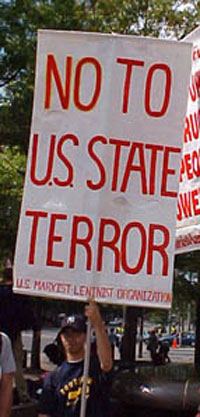 Voice of Revolution joins people nationwide in mourning the deaths of those killed in the Boston Marathon bombings and the West, Texas explosion at a fertilizer storage facility. We salute the heroic efforts of first responders and others who quickly acted to assist the hundreds injured in both locations, running toward the explosions, not away. In both cases, the readiness of people to assist each other and take action regardless of their own safety was clear. We condemn the act of terror in Boston. We also condemn the crimes involved in the Texas bombing, crimes of unsafe working conditions, unsafe storage of highly explosive materials, and the unsafe and dangerous location of the facility in a densely populated area near a school and nursing home, all of which killed 14 people and injured close to 200, with some still missing. And while the bombing in Boston is considered a crime meriting a massive police presence and lockdown of the city, Texas is simply called an accident.
Voice of Revolution joins people nationwide in mourning the deaths of those killed in the Boston Marathon bombings and the West, Texas explosion at a fertilizer storage facility. We salute the heroic efforts of first responders and others who quickly acted to assist the hundreds injured in both locations, running toward the explosions, not away. In both cases, the readiness of people to assist each other and take action regardless of their own safety was clear. We condemn the act of terror in Boston. We also condemn the crimes involved in the Texas bombing, crimes of unsafe working conditions, unsafe storage of highly explosive materials, and the unsafe and dangerous location of the facility in a densely populated area near a school and nursing home, all of which killed 14 people and injured close to 200, with some still missing. And while the bombing in Boston is considered a crime meriting a massive police presence and lockdown of the city, Texas is simply called an accident.
What stands out as different in the two situations was the actions of government and policing agencies. The Boston bombings remained top national news the entire week with day-long reporting at the start and the end. A massive police presence of 9,000 FBI and other policing agencies was imposed. The monopoly media endlessly made false reports, then excused them claiming the “speed” of events made it impossible to be factual. Police released a supposed internet quote from one of the individuals about “killing everyone,” which they themselves said could not be verified but was released and repeated anyway.
During the day-long events on Friday, April 19, the language used to describe the young men targeted was meant to dehumanize them. They were “suspects 1 and 2.” They were not, as their many friends described them, friendly, reliable and respectful young men. And they were not considered American either, though the younger brother was a citizen and lived most of his life here, graduating high school in Boston. It is not likely during his wrestling matches that he was singled out as an immigrant from Chechnya. But now, it is endlessly repeated that the brothers were “Chechen terrorists.”
And that is how the young man now detained is being treated. He is being denied his right to a lawyer and interrogated by a Guantánamo-style team. He is guilty, not innocent until proven guilty. It remains to be seen if he will be tried in a military or civilian court or tried at all, considering that torture and other measures will likely be used to secure a “confession.”
Further, the fact that the Marathon itself is used as a training exercise for police and military alike was made clear before the bombings occurred. Bomb-sniffing dogs, snipers, National Guard, were present at the start and finish line and along the course. Then the effort to kill or capture the two young men involved a massive police action and police state measures. The public transit system was shut down, all taxis halted, and the entire city put on lockdown. What is the necessity for such action when one person had already been killed and the other was wounded, on foot and thus could not be far from the area of the shootout? Why the promotion of such fear and the imposing of such measures? Are we to become used to such police actions not backed up by facts or necessity?
It is already known that the government has wrongly identified individuals as being involved in terrorism. It is also the case that the FBI itself has instigated, organized and funded numerous plots using paid informants. Whatever the situation may be in this case, the role of the government and media in whipping up the level of fear and justifying the police actions taken against the whole city are a dangerous precedent. It is a means to make such actions acceptable, to develop public support for them and for the impunity of government to impose such measures in the future using the claim of potential terrorism.
President Obama went to Boston, spoke at the funeral there, and after the young man was detained issued another statement saying, “I’ve instructed the FBI and the Department of Homeland Security and our intelligence community to continue to deploy all the necessary resources to support the investigation, to collect intelligence, and to protect our citizens.” He added, “We will determine what happened. We will investigate any associations that these terrorists may have had. And we’ll continue to do whatever we have to do to keep our people safe.”
The same is not the case for Texas. The government is not promising to deploy “all necessary resources” to investigate the cause of the explosion and the responsibility of the company and government for the deaths and injuries that occurred. There are no promises to “do whatever we have to do to keep our people safe.” While the president did convey his condolences to the people of West, and said they “will have the resources that they need to recover and rebuild,” investigating the cause of the explosion and responsibility for it is not considered urgent. Why are the deaths and injuries from a fertilizer bomb a tragedy — but not a crime?
West Fertilizer had two 12,000-gallon tanks for anhydrous ammonia, which is stored as a liquid under high pressure. It was also storing up to 540,000 pounds of ammonium nitrate, a highly explosive chemical. Ammonium nitrate fertilizer is responsible for one of the worst industrial accident in U.S. history, when it caused a container ship to explode in 1947 in Texas City, Texas, killing more than 500 people. It also was combined with fuel and used by Timothy McVeigh in the bombing of the federal building in Oklahoma City on April 19, 1995. Yet the facility was allowed to be located in a residential area near a school and nursing home, with no emergency plans or equipment in place to deal with a potential ammonium nitrate explosion. West Fertilizer also said in its 2011 risk management plan filed with the Environmental Protection Agency (EPA) that its anhydrous ammonia did not pose any threat of fire or explosions. It remains unclear what caused the initial fire and the massive explosion that followed, killing five volunteer firefighters and four other first responders.
The blast, which shook the ground with the force of a magnitude 2.1 earthquake, all but obliterated a five- to six-block radius around the plant. It wrecked about 50 to 75 homes and the school. A 50-unit apartment complex had its walls torn off and its roof peeled back. Dangerous chemicals still threaten search and rescue efforts.
A spokesman for the National Council for Occupational Safety and Health admitted, “We need a system in which facilities that are inherently dangerous are required to develop detailed disaster prevention plans before they’re allowed to operate.” Yet this inherently dangerous facility has been allowed to operate and to date is not being held accountable for the deaths and injuries — and nor is the government which allowed it to operate.
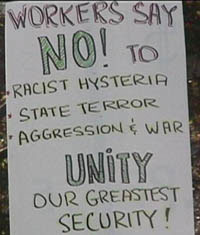 There were more deaths, injuries and destruction in Texas, the danger still persists, but it does not provide the opportunity for inflaming fears and engaging in police state exercises. The deaths of workers at the hands of companies are not considered crimes meriting “all the necessary resources” to investigate and ensure actions are taken to “keep our people safe.” Voice of Revolution rejects the police state actions in Boston and government manipulation of public sentiments and concerns to justify them, and prepare conditions for similar actions in the future. Individuals suspected of acts of terror are innocent until proven guilty and have all the same rights as any other individual suspected of a crime, including the right to a lawyer and not to be subjected to torture.
There were more deaths, injuries and destruction in Texas, the danger still persists, but it does not provide the opportunity for inflaming fears and engaging in police state exercises. The deaths of workers at the hands of companies are not considered crimes meriting “all the necessary resources” to investigate and ensure actions are taken to “keep our people safe.” Voice of Revolution rejects the police state actions in Boston and government manipulation of public sentiments and concerns to justify them, and prepare conditions for similar actions in the future. Individuals suspected of acts of terror are innocent until proven guilty and have all the same rights as any other individual suspected of a crime, including the right to a lawyer and not to be subjected to torture.
We also demand that West Fertilizer and the government be held fully accountable for the crimes of the deaths and injuries and destruction in West, Texas and that the federal government act immediately to ensure the safety of all workers and residents in West and those working in and around all chemical and fertilizer factories posing similar dangers.
[TOP]
Terrorist Attacks on the Boston Marathon — Is American Exceptionalism Dying on Life Support?
On Monday, April 15 (or “4/15”), an unconscionable terrorist act was unleashed at the conclusion of the Boston Marathon, an entirely civilian activity. Over the next four days, the response of U.S. law enforcement authorities was initially anarchic and paralyzed. For the first 72 hours, there were no arrests or suspects. Then at mid-evening Friday, Boston-area police officials from local, state and FBI-level enforcement reported arresting, alive, the last of two brothers suspected of perpetrating the bombing.
This cathartic outcome was the culmination of almost 24 hours of quite conventional but thorough police work conducted under intense official and even more intense unofficial scrutiny. On Thursday, publication by the police of a couple of indistinctly photographed possible suspects walking quickly from the bombing area suddenly changed the whole direction that the story seemed to be taking. One suspect, the older of the brothers, was killed that night in a shootout with police near the MIT campus.
As distinct from the plethora of FBI frame-ups of numerous “terrorist attempts,” “4/15” was the first real mass-public terrorist incident on U.S. soil, without any “lone gunman”-type figure, since 9-11. It shares with that far more massively bloody event one extremely important common feature: many layers of security and law enforcement were completely paralyzed for the duration and immediate aftermath of the attack, without themselves being directly attacked. The media guesswork about “whodunit” — all without a lick of evidence — quickly became a flood. On April 18th, three days after the bombing, all this speculation disappeared. Two brothers — Russian immigrants to the U.S. with family connections to the Caucasian post-Soviet Republic of Chechnya — were spotted on digital camera records departing the scene of the bombing.
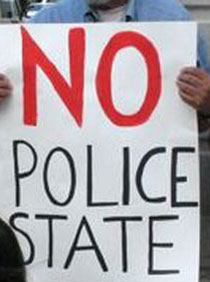 As of early Friday evening, the other brother seemed to have slipped the net, possibly injured. During the preceding 18 hours or so, Boston-proper plus major districts on the north side of the Charles River (across from the city core) had been placed under lockdown as police went door to door. Residents were “advised” neither to go out nor let anyone indoors without police ID. The public atmosphere of paralyzing fear proved sufficiently toxic that close to 100 per cent cooperation with the lockdown was achieved without any level of government having to declare military rule or some other form of state-of-emergency beyond shutting down public transit. Even before the eventual resolution of the police tracking and capture of the sole remaining suspect, there were doubtless many lessons being drawn from this by U.S. authorities at all levels as to how best to line up the U.S. public’s acceptance of the imposition of open fascist emergency rule.
As of early Friday evening, the other brother seemed to have slipped the net, possibly injured. During the preceding 18 hours or so, Boston-proper plus major districts on the north side of the Charles River (across from the city core) had been placed under lockdown as police went door to door. Residents were “advised” neither to go out nor let anyone indoors without police ID. The public atmosphere of paralyzing fear proved sufficiently toxic that close to 100 per cent cooperation with the lockdown was achieved without any level of government having to declare military rule or some other form of state-of-emergency beyond shutting down public transit. Even before the eventual resolution of the police tracking and capture of the sole remaining suspect, there were doubtless many lessons being drawn from this by U.S. authorities at all levels as to how best to line up the U.S. public’s acceptance of the imposition of open fascist emergency rule.
Given the thousands of man-hours their forces put in at the Boston Marathon this week, the paralysis of Homeland Security and FBI officialdom for the first more than 72 hours following the bombing seemed unusually incoherent. There was no coup. At the same time the FBI’s role orchestrating the responses of various levels of state and local law enforcement was everywhere in evidence. At the same time, this FBI element also was and remains a moving target. For example, no representative from the monopoly media has dared yet even to ask whether either suspect or both had become recruited into an FBI-led “sting.” Yet, case after case has surfaced over the last several months in which an FBI undercover agent, inciting one or more members of an illegal conspiracy ultimately to stage some violent act long in the planning, supplies or inserts a dud bomb or bomb-making material, then supplies the eventual court testimony that convicts one or more members of the “conspiracy.”
Taking the longer view of these events in general and the spectrum of reactions to the 2013 Boston Marathon outrage in particular, however, there are more unsettling matters that seem to break the surface. Most notably, quite a lot of even relatively informed commentary about these events inevitably points to the obvious double standard followed by U.S. authorities regarding its financing of terrorist outrages across the Arab-Islamic world while pretending not to see any connections to the infliction of terrorist outrages on U.S. soil. Yet, nowhere is heard a discouraging word about the longstanding U.S.-based ideo-political disease encapsulated in the phrase “American exceptionalism.”
American exceptionalism is a phrase describing a belief in the historical uniqueness of the U.S. experiment in replacing foreign colonial rule with a domestic republican order. Its core belief is that the peoples of the United States are, for all time, utterly immune to and unaffected by any of the rules, norms or lessons of social and economic development that have unfolded in every other corner of the globe. (Also part of this outlook is the presumption, rife throughout the monopoly media of the United States, that American interventions beyond its own territory are undertaken for benign reasons, and never for selfish plundering of the weak by the strong.)
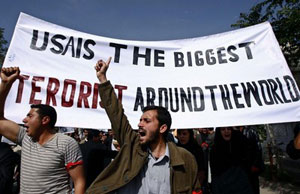 Following 9/11, American exceptionalism was refurbished as an ideological position that apologizes for global state terrorist attacks inflicted by U.S.-led forces. This was heavily disguised as pure and simple revenge for 9/11, yet it led directly to the wars of aggression and occupation in Afghanistan and Iraq, which continue to this day. At the same time, a widespread propaganda issued by partisans of the U.S. Democratic Party was spread over the rest of the eight-year reign of the Bush-Cheney Republicans, attributing their war crimes to the extreme rightward position of the main bloc of Bush-Cheney supporters. Since Obama became president, of course, his administrations continue or expand all the “anti-terrorist” and “homeland security” innovations of Bush-Cheney. Like the Republicans before them, the Democrats claim that U.S. revenge for 9/11 is incomplete. Yet, as was seen throughout the Bush-Cheney years, nowhere is American exceptionalism or its deepening bankruptcy acknowledged.
Following 9/11, American exceptionalism was refurbished as an ideological position that apologizes for global state terrorist attacks inflicted by U.S.-led forces. This was heavily disguised as pure and simple revenge for 9/11, yet it led directly to the wars of aggression and occupation in Afghanistan and Iraq, which continue to this day. At the same time, a widespread propaganda issued by partisans of the U.S. Democratic Party was spread over the rest of the eight-year reign of the Bush-Cheney Republicans, attributing their war crimes to the extreme rightward position of the main bloc of Bush-Cheney supporters. Since Obama became president, of course, his administrations continue or expand all the “anti-terrorist” and “homeland security” innovations of Bush-Cheney. Like the Republicans before them, the Democrats claim that U.S. revenge for 9/11 is incomplete. Yet, as was seen throughout the Bush-Cheney years, nowhere is American exceptionalism or its deepening bankruptcy acknowledged.
Can the U.S. government at any level ever get to the bottom or the truth of whatever force(s) perpetrated this anti-people attack? Today, in an era where the United States is the sole militarily unchallengeable superpower around the globe, there is no way to formulate an answer to this question without revisiting and re-examining what the doctrine of American exceptionalism has become.
More than a decade of numerous evidences have confirmed that the most massive terrorism is being inflicted daily worldwide by U.S. forces. In the teeth of compelling circumstantial evidence of connections to state or local law enforcement, meanwhile, half a dozen mass shooting incidents in the U.S. itself have been pinned on individual perpetrators who were repeatedly instantly declared to be entirely socially isolated “lone gunmen.” After all this, no media outlet connected to the government or private monopoly owners has dared even to hint that the state machinery of the Obama Administration should be scrutinized as part of getting to the bottom of “4/15.”
Thus will the orgy of self-congratulation among the various police forces involved in these recent events eventually pass. Absolutely nothing has changed, or will have changed, as a result. Thus has it come about that the only thing more dysfunctional than the doctrine of American exceptionalism itself turns out to be... denial of unstinting faith in the doctrine of American exceptionalism.
[TOP]
The Cluster Bombs of Boston
and Drone Strikes of Yemen
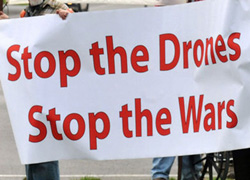 One day last week, I was in a Shawarma shop as the wall-to-wall TV coverage of the Boston manhunt provided the soundscape for lunch. The gentleman behind the counter and I exchanged words of sadness about the sickness infecting those who would commit the kind of violence we saw at the end of the world-famous marathon.
One day last week, I was in a Shawarma shop as the wall-to-wall TV coverage of the Boston manhunt provided the soundscape for lunch. The gentleman behind the counter and I exchanged words of sadness about the sickness infecting those who would commit the kind of violence we saw at the end of the world-famous marathon.
“This reminds me of growing up in Lebanon,” he told me. “Every day, during the war, bombs like this would go off all the time.” Hundreds were indiscriminately killed, like those killed this past week in Iraq by car bombs, and in Afghanistan and Pakistan and Yemen by U.S. air strikes. As the lunch hour went on and the stenographers to power struggled to fill the airwaves with commentary, the inevitable questions arose. Was anywhere safe, given something bad could happen on a moment’s notice? What drives a person to do this?
“Why did these young men who grew up and studied here as part of our communities and our country resort to such violence?” asked Barack Obama on Friday night. It is a testament to the self-censorship of global media that Obama can ask such a question without a hint of irony, nor without a single voice asking the same question of the Harvard-trained, constitutional lawyer Obama himself, who two days earlier signed off on the latest of his daily kill lists, resulting in the extrajudicial murder of two individuals in the town of Wessab, Yemen.
Writer Farea Al-Muslimi, in an Al Monitor editorial, “My Village Was Attacked By US Drones in Yemen,” describes a sense of bewilderment that his village could be attacked, one that must have mirrored the sense of outrage felt by Bostonians when their trademark marathon was bombed. “If you live in Yemen, the golden rule is to expect anything any time,” al-Muslimi wrote. “That, however, does not include expecting your hometown village — one of the most peaceful and beautiful places in Yemen — to be bombed. The peacefulness of such a place makes you believe that no one has ever heard of it, let alone that it is bombed by a US drone strike at night.... The ominous buzz of the drones terrorizes communities. Where will they strike? Will I be next? These are the questions youngsters now grow up asking...The ‘collateral damage’ of drones cannot just be measured in corpses. Drones are traumatizing a generation.”
Based on the daily trauma of drone strikes, the editorial concludes, “It is tempting to conclude that the US has no interest in a measured response to terrorism. It is difficult not to think it doesn’t matter to them whether they terrorize (and radicalize) entire populations as they check another name off their ‘kill list.’”
That nagging question about who would do such things arose again during a White House press briefing, where the pack mentality was briefly broken by a very brave correspondent, Amina Ismael, who put it plainly: “I send my deepest condolence to the victims and families in Boston. But President Obama said that what happened in Boston was an act of terrorism. I would like to ask, do you consider the U.S. bombing on civilians in Afghanistan earlier this month that left 11 children and a woman killed a form of terrorism? Why or why not?”
White House spokesflak Jay Carney’s answer was typical bafflegab, and the rest of the reporters fell in with softball questions more befitting the narrative of the day. Meanwhile, editorial pages lit up with the not unexpected think pieces about “radicalization,” with Canadian national security industry spokesman Wesley Wark struggling to understand how “seemingly well-integrated young men can come to take up the cause of mass casualty violence and terrorism.” It is a testament either to his poor scholarship or his willful blindness that Wark concludes that, despite a decade of counter-terrorism efforts, “we are no closer to possessing a definitive answer.”
Wark wonders about the motives of individuals who would seek to “kill and maim,” but rather misses a key point. The suspects were acting no differently than a general in the Pentagon when they detonated a crude version of weapons that are a regular part of many a military arsenal: cluster bombs, anti-personnel weapons that are no different in their intended use than the Boston bomb, designed to rip apart human flesh and inflict maximum suffering. These things have been dropped millions of times on civilian targets by air forces whose pilots have received medals of bravery.
 Wark and others might also benefit from a brilliant piece of 1970s research by Dane Archer and Rosemary Gartner called “Peacetime Casualties: The Effects of War on the Violent Behavior of Noncombatants.” This analysis, which documents substantive increases in domestic homicide rates following a war, begins by stating the problem that is largely dismissed as part of the “root causes” argument: “Violence by the State is strangely absent from discussions of violence. Books about aggression, for example, often treat topics ranging from hormones to homicidal criminals without mentioning capital punishment, the shooting of looters, the beating of protesters, or even that most impressive form of ‘official’ violence: war.”
Wark and others might also benefit from a brilliant piece of 1970s research by Dane Archer and Rosemary Gartner called “Peacetime Casualties: The Effects of War on the Violent Behavior of Noncombatants.” This analysis, which documents substantive increases in domestic homicide rates following a war, begins by stating the problem that is largely dismissed as part of the “root causes” argument: “Violence by the State is strangely absent from discussions of violence. Books about aggression, for example, often treat topics ranging from hormones to homicidal criminals without mentioning capital punishment, the shooting of looters, the beating of protesters, or even that most impressive form of ‘official’ violence: war.”
The legitimation of official violence, they argue, becomes so embedded in the culture that the core message — “the unmistakable moral lesson that homicide is an acceptable, or even praiseworthy, means to certain ends” — becomes mirrored in the population at large. A majority of nations involved in wars experienced homicide rates that increased significantly compared to nations not involved, revealing a “linkage between the violence of governments and the violence of individuals. This linkage is mediated, we believe, by a process of legitimation in which wartime homicide becomes a high-status, rewarded model for subsequent homicides by individuals .The wartime reversal of the customary peacetime prohibition against killing may somehow influence the threshold for using homicidal force as a means of settling conflict in everyday life.” Put more succinctly, U.S. Justice Louis Brandeis famously wrote in 1928: “Crime is contagious. If the government becomes a lawbreaker, it breeds contempt for the law.”
Another answer can be found in our recent history. A media obsessed with anniversaries (the one week anniversary of Boston, the 100th commemoration of the First World War, the latest day count of Lindsay Lohan’s sobriety) failed to [notice] the 45th anniversary of a story that was originally reported as an American military victory.
On March 15, 1968, young American soldiers went into a Vietnamese village and when asked by a soldier, “Are we supposed to kill women and children?” were told by their commanding officer, “Kill anything that moves.” As Nick Turse further recounts in his excellent history of U.S. war crimes in Vietnam, Kill Anything That Moves, “Over four hours, members of Charlie Company methodically slaughtered more than five hundred unarmed victims. They even took a quiet break to eat lunch in the midst of the carnage. Along the way, they also raped women and young girls, mutilated the dead, systemically burned homes, and fouled the area’s drinking water.” Such atrocities were the norm, not the exception, and Turse notes that massacres were so common that the Pentagon formed a secret Vietnam War Crimes Working Group.
While ordinary soldiers committed these heinous acts, they were, like the tortures, renditions, and mass slaughters from the skies of today, part of the official command structure. War criminal Henry Kissinger relayed the murderous orders of President Nixon on the bombing of Cambodia, instructing the Air Force: “Anything that flies on anything that moves.”
That genocidal mentality (rooted very much in the slaughter of indigenous populations and the ethnic cleansing symbolized by “residential” schools) was also reflected in the deliberate targeting of Iraq’s electricity grid and water treatment systems during the 1991 Gulf War, with the U.S. Air Force noting in a 1998 report that “The loss of electricity shut down the capital’s water treatment plants and led to a public health crisis from raw sewage dumped in the Tigris River.” A U.S. Defense Intelligence Agency analysis entitled “Iraq Water Treatment Vulnerabilities,” noted that sanctions (which killed 1.5 million people, and were “worth it,” according to former U.S. Secretary of State Madeleine Albright) would prevent the importation of the necessary equipment to purify water, leading to “a shortage of pure drinking water for much of the population” and “increased incidences, if not epidemics, of disease.”
 Perhaps the real question is: What radicalized U.S. officials to so hate civilian populations around the globe that such atrocities could be planned and carried out? Another opportunity to understand the “radicalization” of American officials (and their Canadian counterparts) was lost with the media’s failure to provide an equal amount of coverage to two well-documented reports on complicity in torture. One report (Globalizing Torture) found 54 nations (including Canada) provided assistance to the U.S. program of rendition to torture, while another (The Report of the Constitution Project’s Task Force on Detainee Treatment), a bipartisan effort undertaken by some very conservative elements, including members of the military, found it “indisputable” that the U.S. has been complicit in torture, and expressed its concern at “the kind of considered and detailed discussions that occurred after September 11, directly involving a president and his top advisors on the wisdom, propriety, and legality of inflicting pain and torment on some detainees in our custody. Despite this extraordinary aspect, the Obama administration declined, as a matter of policy, to undertake or commission an official study of what happened, saying it was ‘unproductive’ to ‘look backwards’ rather than forward.”
Perhaps the real question is: What radicalized U.S. officials to so hate civilian populations around the globe that such atrocities could be planned and carried out? Another opportunity to understand the “radicalization” of American officials (and their Canadian counterparts) was lost with the media’s failure to provide an equal amount of coverage to two well-documented reports on complicity in torture. One report (Globalizing Torture) found 54 nations (including Canada) provided assistance to the U.S. program of rendition to torture, while another (The Report of the Constitution Project’s Task Force on Detainee Treatment), a bipartisan effort undertaken by some very conservative elements, including members of the military, found it “indisputable” that the U.S. has been complicit in torture, and expressed its concern at “the kind of considered and detailed discussions that occurred after September 11, directly involving a president and his top advisors on the wisdom, propriety, and legality of inflicting pain and torment on some detainees in our custody. Despite this extraordinary aspect, the Obama administration declined, as a matter of policy, to undertake or commission an official study of what happened, saying it was ‘unproductive’ to ‘look backwards’ rather than forward.”
As people around the globe, from Boston Massachusetts to Wessab, Yemen and the Kunar province of Afghanistan remember the dead and care for the wounded in their communities, all victimized by acts of terrorism, it remains our collective task to not only seek accountability, but also a consistent recognition of -- and action responding to the fact — that terrorism is committed with our tax dollars, by our governments, in our name.
(Matthew Behrens is a freelance writer and social justice advocate who co-ordinates the Homes not Bombs non-violent direct action network. He has worked closely with the targets of Canadian and U.S. ‘national security’ profiling for many years.)
[TOP]
The Guantánamo Bay System of
Indefinite Detention
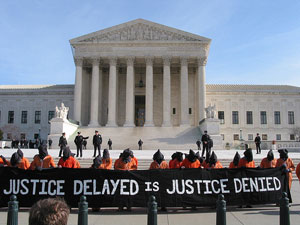 The New York Times on April 15 published an op-ed by Samir Naji al Hasan Moqbel, a Yemeni national currently on hunger strike at the U.S. torture camp and prison at Guantánamo Bay to protest the brutal conditions and indefinite detention without charges. He has himself been detained without charges for more than 11 years.
The New York Times on April 15 published an op-ed by Samir Naji al Hasan Moqbel, a Yemeni national currently on hunger strike at the U.S. torture camp and prison at Guantánamo Bay to protest the brutal conditions and indefinite detention without charges. He has himself been detained without charges for more than 11 years.
Moqbel “wrote” the op-ed through an interpreter and a telephone conversation with his lawyers at the human rights group Reprieve. He describes the horrible conditions which prompted the hunger strike in which he and other detainees are participating and, particularly, the supreme injustice of being locked in a cage indefinitely without any evidence of wrong-doing presented or any opportunity to contest the accusations against them.
The horrific conditions were underscored by reports that on the weekend the op-ed was published, guards at the torture camp shot rubber bullets at some of the detainees to force them into single cells.
Moqbel says among other things:
“I’ve been on a hunger strike since Feb. 10 and have lost well over 30 pounds. I will not eat until they restore my dignity.
“I’ve been detained at Guantánamo for 11 years and three months. I have never been charged with any crime. I have never received a trial.
“I could have been home years ago — no one seriously thinks I am a threat — but still I am here. Years ago the military said I was a ‘guard’ for Osama bin Laden, but this was nonsense, like something out of the American movies I used to watch. They don’t even seem to believe it anymore. But they don’t seem to care how long I sit here, either....
“The only reason I am still here is that President Obama refuses to send any detainees back to Yemen. This makes no sense. I am a human being, not a passport, and I deserve to be treated like one.
“I do not want to die here, but until President Obama and Yemen’s president do something, that is what I risk every day.
“Where is my government? I will submit to any ‘security measures’ they want in order to go home, even though they are totally unnecessary.
“I will agree to whatever it takes in order to be free. I am now 35. All I want is to see my family again and to start a family of my own.
“The situation is desperate now. All of the detainees here are suffering deeply. At least 40 people here are on a hunger strike. [Current estimate is 100 prisoners on hunger strike — VOR Ed. Note] People are fainting with exhaustion every day. I have vomited blood.
“And there is no end in sight to our imprisonment. Denying ourselves food and risking death every day is the choice we have made.
“I just hope that because of the pain we are suffering, the eyes of the world will once again look to Guantánamo before it is too late.”
Former U.S. constitutional lawyer Glenn Greenwald, who writes for the Guardian on civil liberties and U.S. national security issues, provides the following pertinent information:
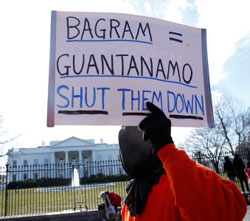 “More than half of the remaining 166 detainees at Guantánamo are Yemeni. Dozens of those Yemenis (along with dozens of other detainees) have long ago been cleared for release by the U.S. government on the grounds that there is no evidence to believe they are a threat to anyone. A total of 87 of the remaining detainees — roughly half — have been cleared for release, of which 58 are Yemeni. Not even the U.S. government at this point claims they are guilty or pose a threat to anyone.
“More than half of the remaining 166 detainees at Guantánamo are Yemeni. Dozens of those Yemenis (along with dozens of other detainees) have long ago been cleared for release by the U.S. government on the grounds that there is no evidence to believe they are a threat to anyone. A total of 87 of the remaining detainees — roughly half — have been cleared for release, of which 58 are Yemeni. Not even the U.S. government at this point claims they are guilty or pose a threat to anyone.
“The Yemeni government not only is willing to take them, but is now demanding their release, using language notably harsh for a U.S. puppet regime.”
Yemen’s president, Abed Rabbo Mansour Hadi in an interview with the Arabic language channel of Russia Today said: “We believe that keeping someone in prison for over 10 years without due process is clear-cut tyranny. The United States is fond of talking democracy and human rights. But when we were discussing the prisoner issue with the American attorney general, he had nothing to say.”
Greenwald noted that “in January, 2010, President Obama [...] announced a moratorium on the release of any Yemeni detainees, even ones cleared for release.” Amnesty International explained that the administration “had decided that four dozen of the Guantánamo detainees could neither be prosecuted nor released, but should remain in indefinite military detention without charge or criminal trial. The administration also imposed a moratorium on repatriation of Yemeni detainees and said that 30 such detainees would be held in ‘conditional’ detention based on ‘current security conditions in Yemen.’ This moratorium is still in place.”
Greenwald cites a Boston Globe editorial that says, “Even Shaker Aamer, a British resident cleared for release years ago, remains at Guantánamo, despite the British government’s public and repeated requests that he be sent home.
“[...] Obama appears to have thrown in the towel on Guantánamo. In January, he closed the office of the envoy who led the effort to close the facility. Now, the US military is investing in a fiber optic cable to the base and planning for specialized medical care for ‘aging detainees.’ That suggests that some will be held there for the rest of their natural lives.”
Greenwald points out, “The last detainee to die at the camp, Adnan Farhan Abdul Latif, who allegedly killed himself in September, was a Yemeni who had never been charged with a crime and had been cleared for release, but, when it was apparent he was going nowhere, ‘had regularly gone on hunger strikes and been sedated or placed on suicide watch.’ Independently, the worsening conditions at the camp that the detainees are protesting are under the exclusive province of Obama as Commander-in-chief.”
In early 2010, when Obama issued his Executive Order to preserve Guantánamo’s system of indefinite detention, Republican Congressman Peter King lauded Obama: “I commend the Obama Administration for issuing this Executive Order. The bottom line is that it affirms the Bush Administration policy that our government has the right to detain dangerous terrorists until the cessation of hostilities.” Greenwald explains the import of such support: “Peter King, widely regarded as a national security extremist and anti-Muslim bigot, has continuously praised Obama’s policies in the ‘War on Terror’ generally.”
[TOP]
28-Year Inspection Gap at
Deadly Texas Fertilizer Plant
 The West, Texas, fertilizer plant, where a fire and explosion last week claimed at least 14 lives — including 11 firefighters and EMTs — and injured more than 200, was last inspected by the Occupational Safety and Health Administration (OSHA) in 1985.
The West, Texas, fertilizer plant, where a fire and explosion last week claimed at least 14 lives — including 11 firefighters and EMTs — and injured more than 200, was last inspected by the Occupational Safety and Health Administration (OSHA) in 1985.
In 2011, the West Fertilizer Co. filed an emergency response plan with the U.S. Environmental Protection Agency (EPA) that said there was no risk of fire or explosion, despite the fact that as much as 54,000 pounds of flammable and toxic anhydrous ammonia could be stored on the site.
While the plant reported that it was storing up to 270 tons of highly explosive ammonium nitrate to state authorities — Oklahoma City bomber Timothy McVeigh needed just two tons to blow up the federal building and kill 168 people — it did not report that fact to the U.S. Department of Homeland Security.
In addition, several other federal and state agencies had pieces of the regulatory responsibility to protect the workers and community. The plant was surrounded by homes, a senior citizen housing project and a nearby school. […]
While those state and federal agencies may inspect certain segments of a plant’s operations — emissions, for example — OSHA is the agency with the broadest mandate and authority to inspect a plant’s entire operations, enforce safety and health laws and, if need be, shut it down. But as the 2012 AFL-CIO report Death on the Job notes, OSHA is so understaffed and underfunded that federal inspectors can inspect each workplace on average, once every 131 years.
There are some 2,200 OSHA inspectors for the country’s 8 million workplaces and 130 million workers. In Texas, OSHA conducted 4,448 inspections in the past fiscal year, a pace that would mean it would visit every workplace in 126 years, according to Death on the Job. […]
BlueGreen Alliance Executive Director David Foster calls the 35-year gap, since the last inspection at the West Fertilizer plant, “a stunning indictment” of OSHA’s underfunding. […]
Small budgets also make it even harder for the agency to issue new safety standards. The agency’s budget is similar to what it was several decades ago, but the size of the economy — and the number and complexity of workplaces to inspect — has grown tremendously. […] [TOP]
(AFL-CIO Blog)
Death on the Job: The Toll of Neglect
This 2012 edition of Death on the Job: The Toll of Neglect marks the 21st year the AFLCIO has produced a report on the state of safety and health protections for America’s workers.
Four decades ago, in 1970, Congress enacted the Occupational Safety and Health Act promising workers in this country the right to a safe job.
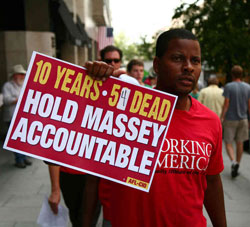 Since that time, workplace safety and health conditions have improved. But too many workers remain at serious risk of injury, illness or death, as demonstrated by three 2010 disasters: the explosion at the Massey Energy Upper Big Branch mine in West Virginia that killed 29 coal miners — the worst coal mine disaster in 40 years; the Tesoro Refinery explosion in Washington State that killed seven workers; and the BP/Transocean Gulf Coast oil rig explosion that killed 11 workers and caused a massive environmental and economic disaster.
Since that time, workplace safety and health conditions have improved. But too many workers remain at serious risk of injury, illness or death, as demonstrated by three 2010 disasters: the explosion at the Massey Energy Upper Big Branch mine in West Virginia that killed 29 coal miners — the worst coal mine disaster in 40 years; the Tesoro Refinery explosion in Washington State that killed seven workers; and the BP/Transocean Gulf Coast oil rig explosion that killed 11 workers and caused a massive environmental and economic disaster.
In 2010, according to data from the Bureau of Labor Statistics, 4,690 workers were killed on the job—an average of 13 workers every day — and an estimated 50,000 died from occupational diseases. More than 3.8 million work-related injuries and illnesses were reported, but this number understates the problem. The true toll of job injuries is two to three times greater — about 7.6 million to 11.4 million job injuries and illnesses each year.
The risk of job fatalities and injuries varies widely from state to state, in part due to the mix of industries. West Virginia led the country with the highest fatality rate (13.1 per 100,000), followed by Wyoming (11.9), Alaska (11.8), South Dakota (8.6) and North Dakota (8.4). The lowest state fatality rate (0.9 per 100,000) was reported in New Hampshire, followed by Massachusetts (1.7), Rhode Island (1.8) and California, Delaware and New Jersey (2.0). This compares with a national fatality rate of 3.6 per 100,000 workers in 2010.
Latino workers continue to be at increased risk of job fatalities, with a fatality rate of 3.9per 100,000 workers in 2010. There were 707 fatal injuries among Latino workers, down from 713 in 2009. Sixty-two percent of these fatalities (441 deaths) were among workers born outside the United States.
The cost of job injuries and illnesses is enormous — estimated at $250 billion to $300billion a year.
The number of workplace inspectors is woefully inadequate. The federal Occupational Safety and Health Administration (OSHA) and the state OSHA plans have a total of 2,178 inspectors (892 federal and 1,286 state inspectors) to inspect the 8 million workplaces under the OSH Act’s jurisdiction. Federal OSHA can inspect workplaces on average once every 131 years; the state OSHA plans can inspect them once every 73years. The current level of federal and state OSHA inspectors provides one inspector for every 58,687 workers. OSHA penalties are too low to deter violations. The average penalty for a serious violation of the law in FY 2011 was $2,107 for federal OSHA and $942 for the state plans. Even in cases of worker fatalities, penalties are very weak. For FY 2011, the median initial total penalty in fatality cases investigated by federal OSHA was $11,197, with a median penalty after settlement of $7,900. For the OSHA state plans, the initial median total penalty was $6,662, reduced to $5,900 after settlement. South Carolina had the lowest median current penalty for fatality investigations, with $1,688 in penalties assessed, followed by Idaho ($1,750) and Utah ($1,850). Rhode Island had the highest median current penalty ($43,880), followed by Minnesota ($26,375) and Wyoming ($20,400).
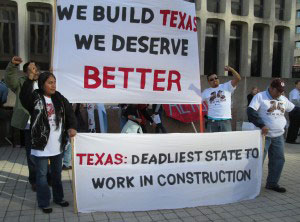 Criminal penalties under the OSHA law are weak. They are limited to cases in which a willful violation results in a worker death and are misdemeanors. Since 1970, only 84cases have been prosecuted, with defendants serving a total of 89 months in jail. During this time there were more than 370,000 worker deaths. By comparison, in FY 2011 there were 371 criminal enforcement cases initiated under federal environmental laws and 249defendants charged, resulting in 89.5 years of jail time and $35 million in penalties — more cases, fines and jail time in one year than during OSHA’s entire history. […]
Criminal penalties under the OSHA law are weak. They are limited to cases in which a willful violation results in a worker death and are misdemeanors. Since 1970, only 84cases have been prosecuted, with defendants serving a total of 89 months in jail. During this time there were more than 370,000 worker deaths. By comparison, in FY 2011 there were 371 criminal enforcement cases initiated under federal environmental laws and 249defendants charged, resulting in 89.5 years of jail time and $35 million in penalties — more cases, fines and jail time in one year than during OSHA’s entire history. […]
Workers in the United States need more safety and health protection, not less. Four decades after the passage of OSHA, there is much more work to be done.
The tragedy at Massey Energy’s Big Branch Mine and the explosion at the Tesoro Refinery highlighted serious problems in job safety protections and laws. At MSHA, many coal operators contest violations to try to avoid being cited for a pattern of violations and subject to tougher enforcement, including suspending dangerous operations. At OSHA, the agency has no authority to require the correction of hazards while employer contests of violations are pending. […]
The Occupational Safety and Health Act is now more than 40 years old and is out of date. Congress should pass the Protecting America’s Workers Act to extend the law’s coverage to workers currently excluded, strengthen civil and criminal penalties for violations, enhance anti-discrimination protections and strengthen the rights of workers, unions and victims.
The nation must renew the commitment to protect workers from injury, disease and death and make this a high priority. Employers must meet their responsibilities to protect workers and be held accountable if they put workers in danger…
[TOP]
